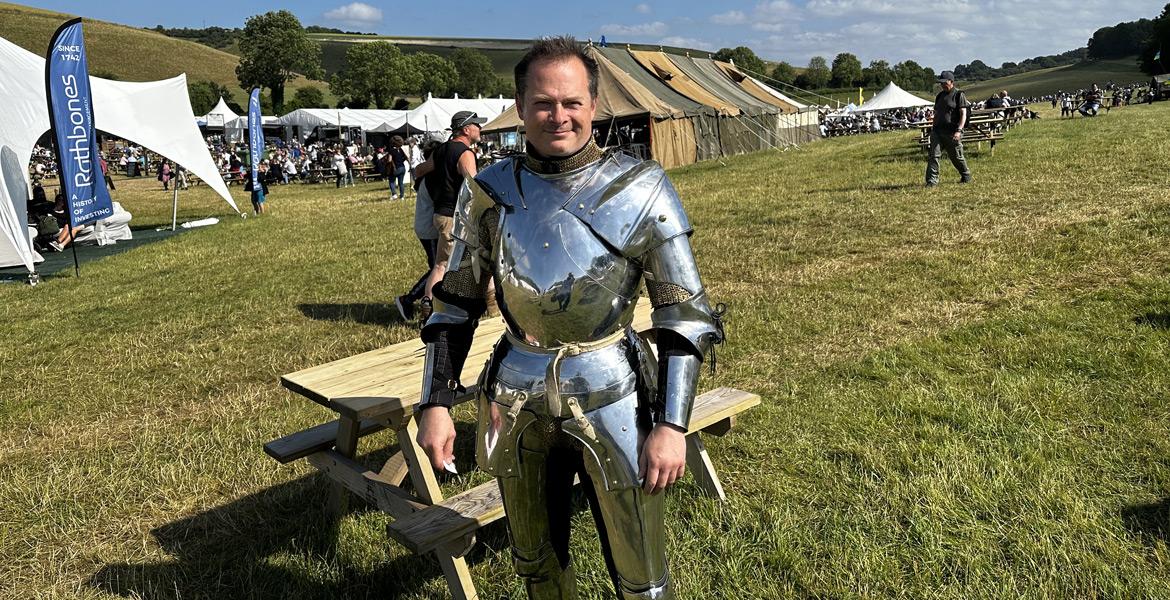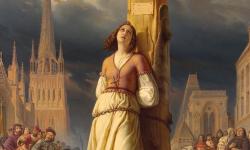Tobias Capwell: In Conversation
Dr Tobias Capwell is, almost literally, a knight in shining armour. A specialist in medieval arms and armour, he has written a number of books on the subject and previously been curator for the Wallace Collection. But, taking his passion to the extreme, he is also an expert martialRelating to fighting or war. artist, a maker of mail, and a jouster, touring the world to perform daring deeds on horseback. It was at one of these events, where he could be found wowing crowds in the arena at Chalke Valley History Festival, that we met him for a chat about his unusual interests.
You're an expert on medieval armour and a jouster; how did you get into it?
The earliest memory I have of arms and armour and knights occurs when I was about five years old. My grandmother took me to the Metropolitan Museum of Art in New York, which has one of the world's greatest collections of medieval and RenaissanceA European revival of learning, art and literature influenced by classical history and culture. It started in Florence, Italy in the 14th century and spread to the rest of Europe in the 14th to 16th centuries. arms and armour. They have it all in this beautiful daylit gallery, with sunlight streaming in and heraldic banners on the walls, and in the middle of the room there is this group of equestrian figures, knights on horses. For me, seeing that was transformative. It was an awesome experience in the true sense of the word. I've spent years trying to understand that moment – what it is about the image of the armoured knight that has this extraordinary power. Yes, he's a warrior; yes, he fights on the battlefield. But knights are living works of art as well, and they have enormous expressive power. The aristocracyA generic term for the highest social class. in any traditional society, and certainly in medieval Europe, ruled by divine right: their claim was that God chose this group of people to reign supreme on Earth. They are the wielders of divine power. But that's a pretty big claim. Even in the Middle Ages, you can't expect people to take that on faith. They need tangible evidence that the order of the universe really is like that, and the knights are the living proof that it's true. They are radiating the light of the sun, shining beings trained to fight since the age of four or five years old. They have the luxury of time, and aristocratic status, and money to train to fight and do very little else. Knights are a bit like virtuoso musicians, except they fight instead of play music (although some knights were great musicians as well).
Then you've got the chivalric code.
ChivalryA knightly code of correct social, religious and moral behaviour. is often deeply misunderstood, so it's important to be clear about what it is. It is a code of behaviour and ethics, but it only applies to the aristocracy: it isn't a set of general guidelines about being good to other people. It's about the way you treat your equals as an aristocratic warrior. But the word 'chivalry' just means horsemanship – it's really only the state of being a knight. And then there are various rules and regulations and codes of behaviour that mean different things to different people at different times. What chivalry means in the twelfth century is very different from what it means in the sixteenth century.
But the knight and the chivalric ideal endured for a lot longer than people think. There's a lot of scholarship that's been produced about chivalry in the sixteenth century and the Renaissance, following Johan Huizinga and others, that characterizes that later period as an age of decadence and decline, as if the knight is the antithesis to modernity. And as we become more modern, the knight becomes outmoded. But this is all modern, historiographical theory: in fact the knight was just as powerful and just as central to society in the sixteenth century as he ever was. It only really started to decline in the later seventeenth century.
Jousting was still very popular at that time, with annual AccessionThe attainment or acquisition of a position of rank or power, often related to the throne. Day tilts for Elizabeth I. What was it that kept jousting so popular?
I've been recently working on jousting in the reign of Henry VIII as a research project, and in writing up my introductory notes I've been thinking about the place of jousting in the royal court in England. I noticed something that shocked me a little bit – although I knew it in the back of my head – but jousting and tournaments and courtly spectacles – formal, cordial combat – were enormously popular in the fourteenth century: Edward III and Richard II loved jousting and chivalric spectacles. They had what they called 'Round Tables' where they had jousts with an ArthurianRelating to, or characteristic of, King Arthur. theme. But then jousting at the royal level in England went into a major decline after Richard II: Henry IV, Henry V, Henry VI, Edward IV, Richard III, none of them really held major jousts at their court. Edward IV had a couple, but jousting was not the hugely popular courtly phenomenon in England that it had been in the fourteenth century. And it didn't become so again until the reign of Henry VII, after he conquered the YorkistsPeople supporting, or belonging to, the House of York during the Wars of the Roses. These included Richard of York and Edward of March (later Edward IV). at Bosworth in 1485. He had a lot of scrambling to do to create the illusion that he was a legitimate king, and he had to do everything he could to shore up his royal power and royal magnificence and look like a medieval king, even though he wasn't one really. One of the things he did was reintroduce really lavish tournaments at his court in the very late fifteenth and early sixteenth centuries, and he spent a lot of money on them.
But interestingly, Henry VII never took part in formal combat personally. It was like whatever social, political, diplomatic benefit could come from the experience of seeing the king himself in a joustA competition in which two opponents on horseback fought with lances., for Henry VII it wasn't worth it. It wasn't worth the risk, regardless of the benefit he could have gotten out of it. He was very conservative in regard to his personal safety and with good reason – most of the best jousters at his court were Yorkists. It’s wise not to joust against someone who might very well want you dead.
His son, Prince Henry – later Henry VIII – from the time he was a child was desperate to joust. He loved martial arts: he had a fight master from the time he was seven years old and loved all that. But during his father's lifetime, Henry was never allowed to joust because he was his father's only son and heir – Henry VII had already lost the elder son, Prince Arthur. So, Henry VII was saying, 'You're not going near a tiltyard, pal!' You get the sense that young Henry was desperately frustrated by that. And as soon as his father died, as soon as Henry VIII became king in 1509, he was straight in there. Suddenly you have this totally new phenomenon of the king taking part personally: he's taking his personal physical fitness, his fighting prowess, and he's presenting it as indicative of the strength and power of the country as a whole. The king becomes the personification of English power, and he uses his personal body as this diplomatic and political tool.
There was a joust at the Field of the Cloth of Gold?
Yes, he jousted there personally. We have some really great observations in the historical accounts. Henry, by 1520, was one of the greatest jousters in Europe. And at several points Edward Hall, the official English chronicler of the Field of Cloth of Gold mentions how he broke various parts of the armour of his opponents. On one course, he busted the pivot on one knight’s helmet, so the whole visor came off. In another instance he broke the gardbrace – the large reinforcing plate on the left shoulder – on another French knight's armour: he smashed it right off. He damaged one lord’s armour so badly that a couple of years later he sent a gift armour to that individual from his court workshop, saying 'Sorry I smashed your kit up. Here's a new one in the latest English style.'
But that's what armour means: it's so personal, so meaningful to these people. What does a fighter jet mean to a pilot? What does the F1 car mean to Lewis Hamilton? It's part of his life. It's who he is. It's everything about him. When he gets in that car, his identity is projected onto the forms of the vehicle. And armour is like that. It stands for these people; it is these people. When you go to the Tower of London and you stand next to the 1540 armour of Henry VIII, that's a much more profound physical experience, in some ways, than looking at a Holbein portrait. Holbein is a good painter, don't get me wrong, but a portrait is a flat piece of wood with pigment and egg smeared on it. With the armour, though, you're standing next to the artificial exoskeleton of the real man – he's stood there with you, in a way. I think I sensed that when I was a little kid: that I was in the presence of these people, even though they’d been dead for hundreds of years. I have to confess that my first thought as a five-year-old looking up at that, I didn't think to myself that I wanted to be a curator at a museum. That all came later. I always wanted to be a knight, from that time onwards.
Which is why you joust now?
We founded the historical jousting community about 30 years ago. It grew from about six people to hundreds. There are major tournaments all over the world now. It's been televised periodically – in Australia it got quite big on ESPN for a while.
Have you ever been seriously injured doing it?
I've only ever had one direct injury in the joust itself, caused by lance interference. It was a type of joust where we were using very long, solid pine lancesLong weapons with wooden shafts used by horsemen when charging their opponents. with steel spearheads. My lance came down and I was aiming for my opponent’s head, so my lance carriage was quite high. Then his lance came down on top of mine and he was trying to press through to get to the shield, but my lance was blocking his, so his lance slid down mine and hit me right in the hand. Two of the points went over my hand, but the third one went right between my finger and thumb and embedded itself in my hand. It was not a really significant injury, but its location meant that I couldn't really hold a lance very well, so it knocked me out of that competition. It was a really funny situation because it happened on the first course, the first run of a set of six. Bang! I got injured on the first one, but I didn’t know it. All I know is I felt an impact on my hand and it was just a bit of a heavy blow. I didn't know I was hurt, but I was bleeding down the butt of the lance. I gave the broken lance to the footmen at the end of the tilt, and they looked down at the blood and looked up at me and said, 'Toby, are you hurt?' And I said, 'No!', and I just turned around and rode off. In the next course, I came through with another good hit, no problem. There was a lot more blood now though; it's running down my armour. I can’t see it – I'm in my helmet. They said, 'Toby, you're hurt.' 'No, I'm not! I'm fine!' So they had to let me finish the whole set of six courses before I even realized there was anything wrong and that I needed to go to the hospital.
Was it the adrenaline that kept you going?
No. When you're in armour and once the visor's down, you can't see very much, you can't hear very much. You don't really know very much about what's going on, on the outside. It’s important to maintain an icy calm, and once you have a fair amount of experience, adrenaline doesn’t really come into it.
It's really interesting you saying about how precious armour feels to you, how it changes how you feel, and how important it is. And yet there are so few pieces of armour that are extant now. Why is that?
The armour that does still exist often survives because of very specific sets of circumstances. There is a huge collection of armour at the Kunsthistorisches Museum in Vienna because most of it was preserved in the private ancestral armoury of the Habsburgs, and Archduke Ferdinand II of Austria in the sixteenth century was also the first antiquarianSomeone who is interested in, or collects, antiques and antiquities. collector at a time when all of the great noblemen of Europe were still wearing armour. He had a habit of writing to these noblemen and asking if he could have one of their armours for his museum in Innsbruck. He created something called the Helden Kammer, the Hall of Heroes, where all of the great generals of his period were represented by their armour, and that then preserved them in a very unusual situation where they had value and therefore they were kept in pristine condition. A historical artefact can only survive (outside of an archaeological context) when it is perceived to have continuing value. A historian might come back in 500 years and yell at me because I didn't preserve the hubcaps on the 1980 Volvo 240 that I drove as a student. In hindsight, that could end up being a real loss because centuries later little is known about automobiles of that period, but too bad, it wasn't important at the time.
There's a period of greatest risk in the preservation of armour. It fell out of military use in the middle of the seventeenth century, but it didn’t become a source of antiquarian interest and academic study until the early nineteenth century. So, you've got at least 150 years, if not almost 200 years, where old armour generally was just regarded as obsolete junk. It's scrap metal, it's from some distant, weird time when they used to wear this stuff. And in the eighteenth century there was a kind of cultural contempt for it because it's now the Age of Enlightenment, and all of this old armour is symbolic of the age of ‘endarkenment’ that came before the 'great realization'. So it's just thrown away. The entire medieval armoury in the Tower of London was sold as scrap. You look at the stories: this happens again and again and again. But also keep in mind, too, that good iron and steel were, for a long time, almost precious metals. You can't afford to let it sit there in some old object when you need good metal now to cut up to make plates for a treasury door or to make shovels or tools or whatever else you can do with cut-up armour. You can't afford to keep it: the materials are too valuable. So there's an incredible amount of recycling that went on for lots of perfectly good reasons, or it was just junk to be thrown away.
Any armour that survives now has done so because it has won repeated rolls of the cosmic dice. There were tens of thousands, if not hundreds of thousands, of full armours made just in Milan – in just one city – in the second half of the fifteenth century. Of all of those hundreds of thousands of armours, 13 survive. And of those 13, about ten of them come from only two very unlikely, flukish preservation contexts, where a bunch of them got stuck in a castle and never got disturbed, when all the other hundreds of castles with armouries got emptied and destroyed and sold off. And then another bunch of them got set up as votive offerings at a weird sanctuary church near Mantua in Italy, and they just never got taken down. But if not for those two very unusual situations, we would have almost no Italian armour surviving at all of thousands and thousands and thousands of them.
So how do you go about researching this very material-based history when it actually no longer exists?
That was the whole focus of my PhD. I'm a practitioner and I wanted to do it before I wanted to study it. I wanted to get in the armour, and I wanted to fight, and I wanted an armour that works the way it's supposed to work. I need to get back to the material reality. Normally when you're a historian and you're looking at documents in the British Library or whatever, you have the intellectual prerogativeA right or privilege exclusive to a particular person or group. to say, 'Here's an area where we don't know anything, there's no evidence. I'm an expert, but in this case, I just don't know what was going on.' It's important to be able to be honest about that. But when I'm reconstructing something to go out and fight, I can't afford to say 'I don't know' because I still need a breastplate and I still need the straps on the inside. There may be no evidence of how they set those up, but I still need them.
So, my role as a practitioner has influenced my academic career and my academic specialism. I have a tendency to be attracted to those black holes in the evidence, because I'm interested in the real human experience of the past. Something was going on; there's something in that black hole. How do we get light in there? How do we use the evidence that we've got more creatively? Or how do we break out of our academic preconceptions and start using other forms of evidence that we might not have considered? If you're a documentary historian, documents are great in lots of ways, but you've still got to go out and look at the material culture. If you're interested in commerceThe activity of buying and selling of goods and services., you've got to look at wagons: how do wagons work; how fast can they go; what's their range; what can you carry in them; what are their limitations? All that material culture, technology, art, it all comes back and you've really got to look at everything. And so that's what I try to do – shed some light into the black holes. No English armour from the fifteenth century survives, so how the heck are you going to do a PhD on it? So I said to myself, 'Well, what have we got? There’s no actual English armour in existence, but we do have 230 of these life-sized, high-relief funerary monuments representing fifteenth-century knights in their armour. And hey, no armour person has ever studied these comprehensively. So why don't we start with that?' And my PhD committee said, ‘That's fine for your PhD, you don't need to do anything else. Just collecting that huge body of evidence and then coming up with some interpretation and analysis, that's the PhD right there.’ It took me way longer than it should have, but I got it done. But then after completing the PhD, in five years, it took me another 15, nearly 20 years to write it all up as published works.
Can you tell me about those published works?
It's the series Armour of the English Knight. Volume 1 covers the period 1400 to 1450; Volume 2 handles 1450 to 1500; and the third volume, which just came out last December, is called Armour of the English Knight: Continental Armour in England, 1435 to 1500. So we have two books that look at the domestic situation, but then the new book, which wasn't part of the original PhD, is all new work and looks at the degree to which the English nobilityThe highest hereditary stratum of the aristocracy, sitting immediately below the monarch in terms of blood and title; or the quality of being noble (virtuous, honourable, etc.) in character. also bought armour from France and FlandersThe modern area of northern Belgium and historically a territory in the Low Countries. and Italy, and what was the continental influence. That's an important part of the story and it touches upon the late medieval concept of Englishness – to what extent did the English think of themselves as unique and different, with their own artistic tastes, their own technologies? That's what the books are about.
It's extremely relevant and timely now.
I didn't intend it to be! I never thought about that really. But it is weirdly relevant now, and it's nice to be relevant when you're a medievalist. It's not always the case.
But also, you were curator for the Wallace Collection in London.
It's one of the national museums of fine and decorative art, with nearly half of the total contents of the building arms and armour. I was the curator there for 16 years from 2006 to the end of 2022. So just for the last six months, I've been embarking on a new career as an independent scholar. I work freelance, I joust, I teach martial arts. I'm teaching jousting technique in Brittany in a few months. I do lots of different kinds of lectures. I advise video game companies. I work sometimes for the BBC and I'm still writing books. It's busy! I try to keep lots of balls in the air and hopefully I don't drop too many of them.
One of the best ways of keeping up with what I'm doing is Instagram! Instagram has been great for me. It's a really easy way of letting people know what I'm up to, and it's a good way to get in touch with me too. I've always been a visual person and most of my academic arguments are built out of visual sources, so Instagram has always been a good fit for me. For people interested in seeing a joust, they can go on Instagram and they can also, if they're old school, check out the website of Historic Equitation – a specialist riding school run by my friend Dominic Sewell, who's one of the country's best classical riding masters. He does classical riding demonstrations all over the country, medieval, Renaissance, early modern riding styles.
- Log in to post comments






